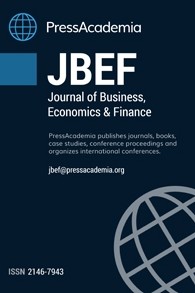THE EFFECTS OF LIABILITY DOLLARIZATION ON MANUFACTURING COMPETITIVENESS
Purpose- This study aims to investigate the effect of liability dollarization on competitiveness of sub-sectors operating in Turkish manufacturing industry. Within the scope of the NACE Rev-2 classification, the study used annual data covering the 2008-2016 period for the sub-sectors of the manufacturing industry. Methodology- A group of econometric tests; fixed effects and random effects approaches have been estimated from panel data methods. Findings- Variables affecting the manufacturing industry competitiveness were found to be liability dollarization, economic globalization index, energy prices, economic crisis, trade openness, and basket exchange rate. The variable to be used as the “measure of competitiveness” to represent the dependent variable is the ratio of net exports to foreign trade volume. The estimation results show that increase in liability dollarization rate, presence of the economic crisis, and change in energy prices negatively affect competitiveness of sectors, whereas economic globalization index and trade openness have a positive effect on the competitiveness. There is no statistical significant impact of basket exchange rate on competitiveness. Conclusion- The results of this study indicate that to increase sectoral competitiveness of Turkish manufacturing sector should be increased openness effect and decreased debt dollarization ratio. While sectors increase openness, they can reach new markets and so they can increase their trade activities. But, to increase sectoral economic activity strongly, their fund problems should be solved.
___
- Aklan N and Nargeleçekenler M (2010). Yükümlülük Dolarizasyonu ve Bilanço Etkisi: Türkiye Üzerine Bir Analiz. İ.Ü. Siyasal Bilgiler Fakültesi Dergisi, 43, 177-204, https://dergipark.org.tr/tr/download/article-file/5272.
- Alp, B. (2013). Türkiye’deki Reel Sektör Firmalarında Borç Dolarizasyonu ve Reel Kur Değişimlerinin Bilanço Etkisi. TCMB Uzman Yeterlilik Tezi.
- Alp, B. and Yalçın, C. (2015). Türkiye’de Şirketlerin Borç Dolarizasyonu ve Büyüme Performansı. TCMB Çalışma Tebliği, N: 15/01,https://www.tcmb.gov.tr/wps/wcm/connect/c8b76887-0ede-4049-9744-a02bdf149d43/bengualp.pdf?MOD=AJPERES&CACHEID=ROOTWORKSPACE-c8b76887-0ede-4049-9744-a02bdf149d43-m3fBab9
- Aydın, Ü., Ekinci, R. and Tüzün, O. (2017). Türkiye’deki Reel Sektörün Finansal Yapısı: Kur Değişimlerinin ve Politik İstikrarsızlığın İmalat Sanayi Üzerine Etkisi. 3rd SCF International Conference on “Economic and Social Impacts of Globalization”. Proceeding Book, 5-14, http://www.scfconferences.com/wp-content/uploads/2019/07/3.SCF-INTERNATIONAL-CONFERENCE-PROCEEDINGS.pdf#page=11
- Bleakley, H and Cowan K (2005). Corporate Dollar Debt and Deprectiations: Much Ado About Nothing?. Inter-American Development Bank Research Department Working Paper No: 532, https://www.econstor.eu/bitstream/10419/88075/1/idb-wp_532.pdf.
- Calvo, G. and Reinhart, C.M. (2002). Fear of Floating. Quarterly Journal of Economics, 117 (2), 379–408, https://www.nber.org/papers/w7993.pdf.
- Chang, R. and A. Velasco (2004). Balance Sheets and Exchange Rate Policy. The American Economic Review, 94(4), 1183-93, https://www.nber.org/papers/w7840.pdf.
- Cowan, K., Hansen, E., and Herrera, L. O. (2005). Currency mismatches, balance-sheet effects and hedging in Chilean non-financial corporations. Balance-Sheet Effects and Hedging in Chilean Non-Financial Corporations IDB Working Paper, 432, https://publications.iadb.org/publications/english/document/Currency-Mismatches-Balance-Sheet-Effects-and-Hedging-in-Chilean-Non-Financial-Corporations.pdf.
- Eichengreen, B. and Hausmann, R. (1999). Exchange Rates and Financial Fragility. Federal Reserve Bank of Kansas City’s Conference on Issues in Monetary Policy, https://www.nber.org/papers/w7418.pdf.
- Gonzalez, A., Micco, A. and Montoya, A. (2015). Dollarization, Foreign Ownership, and Competition in the Banking Industry in Latin America. Emerging Markets Finance and Trade, 51(1), 90-107, DOI: 10.1080/1540496X.2015.998074.
- https://kof.ethz.ch/en/forecasts-and-indicators/indicators/kof-globalisation-index.html
- http://www.oecd.org/ ..................................................................
- http://www.oecd.org/ ..................................................................
- http://www.tcmb.gov.tr ..................................................................
- İncekara, A., Mutlugün, B. and Aksöz Yılmaz, H . (2017). Borç Dolarizasyonunun Türk İmalat Sanayi Sektörü Büyümesi Üzerine Etkisi. İktisat Politikası Araştırmaları Dergisi, 4 (1), 16-38, https://dergipark.org.tr/tr/download/article-file/271599
- Karadam, D. Y. (2018). Effects Of Real Deprecıatıons On Turkısh Manufacturıng Industry: Fınancıal Channel. Institutions, Development and Economic Growth, 11-22.
- Karamollaoğlu, N., and Yalçin, C. (2019). Exports, real exchange rates and dollarization: empirical evidence from Turkish manufacturing firms. Empirical Economics, 1-31, https://link.springer.com/content/pdf/10.1007/s00181-019-01733-1.pdf.
- Kesriyeli, M., Özmen, E. and Yiğit, S. (2005). Corporate Sector Debt Composition and Exchange Rate Balance Sheet Effect in Turkey. Central Bank of Turkey, Research and Monetary Policy Department, WP No. 05/16, https://www.tcmb.gov.tr/wps/wcm/connect/9eacefa5-e2ee-44d3-a300-9fe08184cf12/WP0516ENG.pdf?MOD=AJPERES&CACHEID=ROOTWORKSPACE-9eacefa5-e2ee-44d3-a300-9fe08184cf12-m3fw5MS
- Kesriyeli M., Özmen E. and Yiğit S. (2011). Corporate sector debt composition and Exchange rate balance sheet effect in Turkey. Applied Economics, 43(30), 4741-4747, https://www.tandfonline.com/doi/full/10.1080/00036846.2010.498353.
- Kılıçarslan, Y. and Temurov, I. (2016). Import Substitution, Productivity and Competitiveness: Evidence From Turkish and Korean Manufacturing Industry. Optimum Journal of Economics and Management Sciences, 3(2), 67-83, https://dergipark.org.tr/tr/download/article-file/222756
- Metin-Özcan, K. and Us, V. (2009). What drives dollarization in Turkey?. Journal of Economic Cooperation and Development, 30(4),29-50, http://repository.bilkent.edu.tr/bitstream/handle/11693/22606/What%20drives%20dollarization%20in%20Turkey.pdf?sequence=1&isAllowed=y.
- Özmen E. and Yalçın C. (2007). Küresel Finansal Riskler Karşısında Türkiye’de Reel Sektör Finansal Yapısı ve Borç Dolarizasyon. TCMB Çalışma Tebliği No: 07/06, https://www.tcmb.gov.tr/wps/wcm/connect/de3ade1c-8a57-4787-b8a8-18af2a20dc34/WP0706.pdf?MOD=AJPERES&CACHEID=ROOTWORKSPACE-de3ade1c-8a57-4787-b8a8-18af2a20dc34-m3fw5Pe
- Ranciere, R., Tornell, A. and Vamvakidis, A. (2009). Currency Mismatch and Systemic Risk in Emerging Europe, Economic Policy CEPS and CES and MSH 25, 597-658, https://doi.org/10.1111/j.1468-0327.2010.00251.x.
- Serdengeçti,S.(2005).Dolarizasyon/TersDolarizasyon, Ekim,Eskişehir,https://www.tcmb.gov.tr/wps/wcm/connect/5b404bcd-6e72-415d-a656-91da6db0cc6e/sunumeskisehir.pdf?MOD=AJPERES&CACHEID=ROOTWORKSPACE-5b404bcd-6e72-415d-a656-91da6db0cc6e-m3fBeXh
- Taşseven, Ö. and Çınar, S. (2015). Türkiye’de Borç Dolarizasyonunun Belirleyicileri ve Makroekonomik Göstergeler Üzerindeki Etkileri. Sosyal Bilimler Araştırma Dergisi 4(2), 121-141.
- Yurttançıkmaz, Z. Ç. (2014). Seçilmiş Ülkelerde Rekabet Gücünün Belirleyicileri ve Büyüme İlişkileri. Yayımlanmamış Doktora Tezi, Erzurum Atatürk Üniversitesi.
- Yurttançikmaz, Z. Ç., Kabadayi, B. and Emsen, Ö. S. (2014). Ekonomik Büyüme ve Rekabet Gücü Üzerine Türkiye Analizi. Ekonometri ve Istatistik Dergisi, 21, 21-46
- Yayın Aralığı: Yılda 4 Sayı
- Başlangıç: 2012
- Yayıncı: PressAcademia
